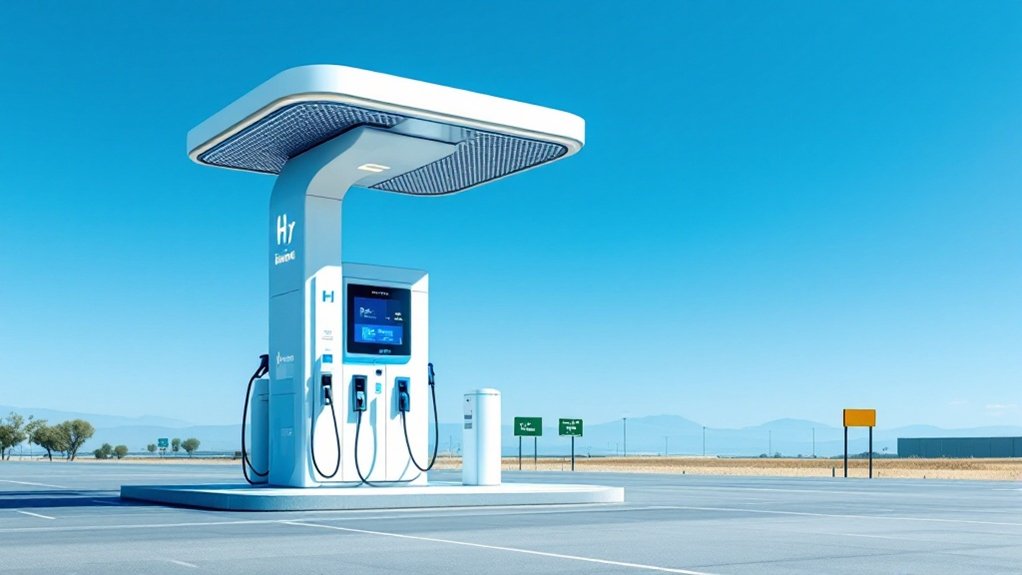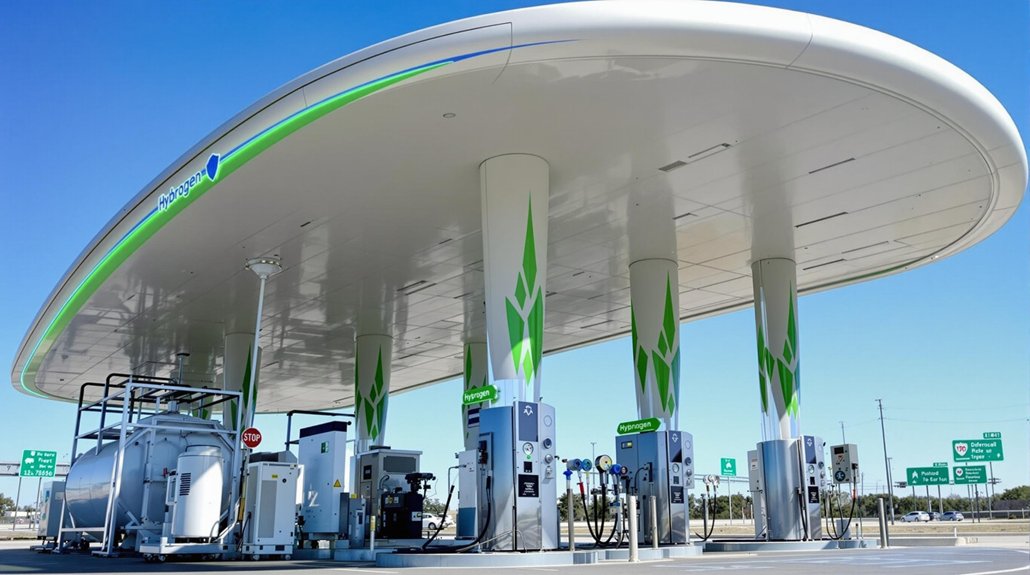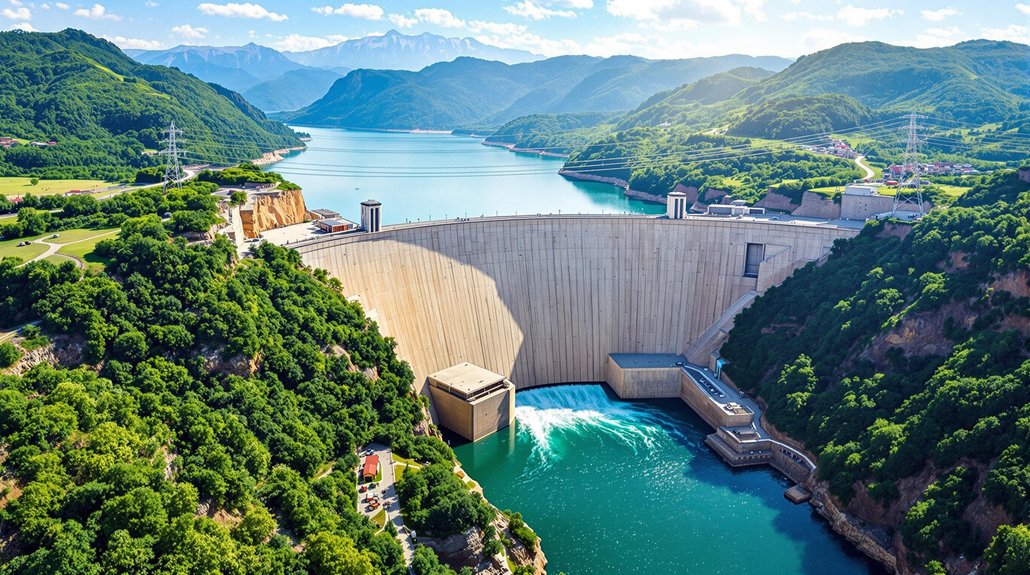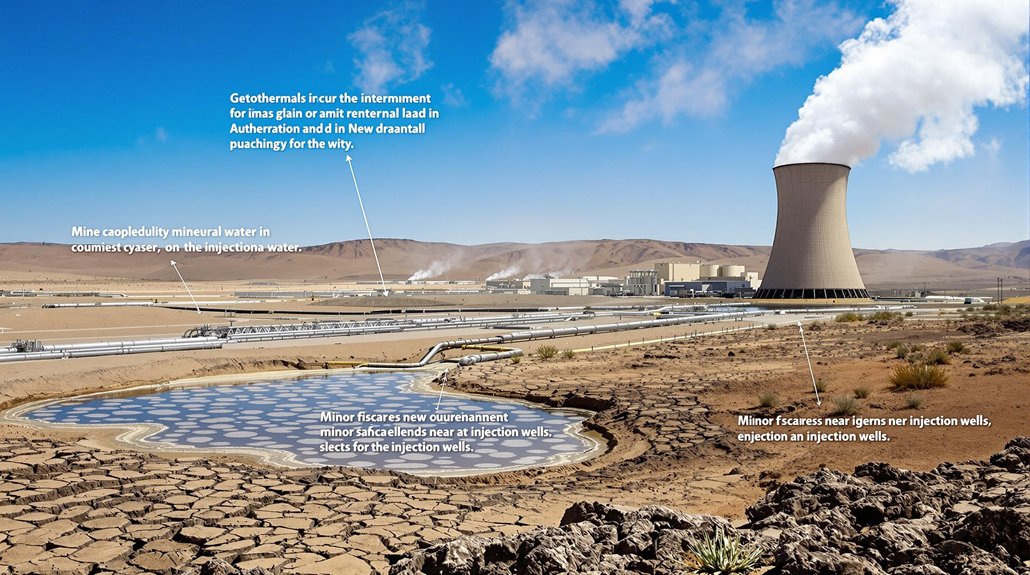The U.S. currently has 74 hydrogen fueling stations, with 54 open to the public. California leads with 42 stations, though 18 are temporarily unavailable. The market is valued at $268.4 million in 2024 and expected to grow to $2.25 billion by 2034. California has 109 retail stations in development. Current infrastructure primarily serves light-duty vehicles, but truck stations are increasing. Further exploration reveals promising growth in this emerging sector.

While hydrogen fuel continues to gain attention as a clean energy option, the United States has been slow to build the necessary infrastructure. As of 2024, there are only 74 hydrogen fueling stations in the entire country. Of these, just 54 are retail stations open to the public.
California leads the nation with 42 stations currently available, though 18 in the state are temporarily unavailable. Outside of California, the hydrogen landscape is sparse. Hawaii has one retail station, while states like Colorado, Massachusetts, Michigan, New York, Ohio, Texas, Virginia, and Washington each have a single non-retail station.
The good news is that California’s hydrogen network is set to grow substantially. The state has 109 retail stations in its development pipeline. This includes 5 under construction, 18 in the permitting process, 10 proposed, and 76 that have received funding but haven’t started development.
Most current stations serve light-duty vehicles, but the market is expanding. California operates 4 hydrogen stations for trucks, with 9 more funded. These larger stations can provide 500-1000 kg of hydrogen daily.
The growth comes from collaboration between government and industry. California leads with state-level support, while federal funding flows through the Department of Energy’s hydrogen hubs program. Companies like Air Liquide, Shell, and True Zero partner with government agencies to build this infrastructure. The 2019 data showed 63 total stations across the United States, indicating modest growth in the hydrogen infrastructure over recent years.
Modern hydrogen stations use 700 bar pressure for light-duty vehicles. Some produce hydrogen on-site, while others receive deliveries. Safety codes like NFPA 2 guide their design. Several companies, including Nel Hydrogen in Wallingford, CT, are actively developing and supplying the specialized equipment needed for these fueling stations.
The U.S. hydrogen station market is valued at $268.4 million in 2024. Experts project it will reach $2.25 billion by 2034, growing at 23.7% annually. While light-duty vehicles currently drive demand, heavy-duty vehicles represent an emerging market that could accelerate growth in coming years.
Frequently Asked Questions
How Much Does It Cost to Refuel a Hydrogen Vehicle?
Refueling a hydrogen vehicle costs about $16.51 per kilogram in California, where most stations exist.
A Toyota Mirai with a 5.6 kg tank requires around $92 for a full refill. This translates to $0.50-$0.80 per mile, making hydrogen 2-3 times more expensive than gasoline.
Manufacturers sometimes offer fuel cards worth $15,000 to offset these high costs. Prices may drop as infrastructure expands.
What Safety Measures Are in Place at Hydrogen Refueling Stations?
Hydrogen refueling stations employ multiple safety systems to prevent accidents.
They’re equipped with gas sensors that detect leaks and automatically shut down systems. Breakaway hoses prevent spills during disconnection.
Stations use specialized ventilation systems to disperse any escaped hydrogen. Fire suppression equipment is designed specifically for hydrogen flames.
Operators receive safety training, and stations feature emergency shut-off buttons accessible to both staff and customers.
How Long Does a Hydrogen Refueling Process Take?
Hydrogen refueling typically takes 3-5 minutes for passenger cars and 7-10 minutes for larger vehicles like buses.
This process is comparable to filling up with gasoline and much faster than charging electric vehicles.
The automated filling procedure involves multiple stages: pressurizing, leak testing, and three filling phases.
Refueling time varies based on tank size, starting pressure, temperature, and station equipment capabilities.
Can Conventional Vehicles Be Converted to Use Hydrogen Fuel?
Converting conventional vehicles to use hydrogen isn’t practical for most car owners. While technically possible, retrofitting requires replacing engines, fuel systems, and transmissions—costs that exceed the vehicle’s value.
Large diesel vehicles like buses are better candidates. Aftermarket conversion kits exist but are unproven and may void warranties.
Hydrogen internal combustion engines can reuse 90% of existing parts but still require significant modifications to fuel injectors and ignition systems.
What Happens if a Hydrogen Station Experiences Technical Problems?
When a hydrogen station has technical problems, safety systems activate immediately.
The station closes to the public while technicians investigate and repair the issue. Gas sensors monitor for leaks and emergency venting systems release pressure if needed.
Nearby stations often see more customers. Minor problems typically cause 1-3 day closures, while major issues can shut down stations for weeks.









